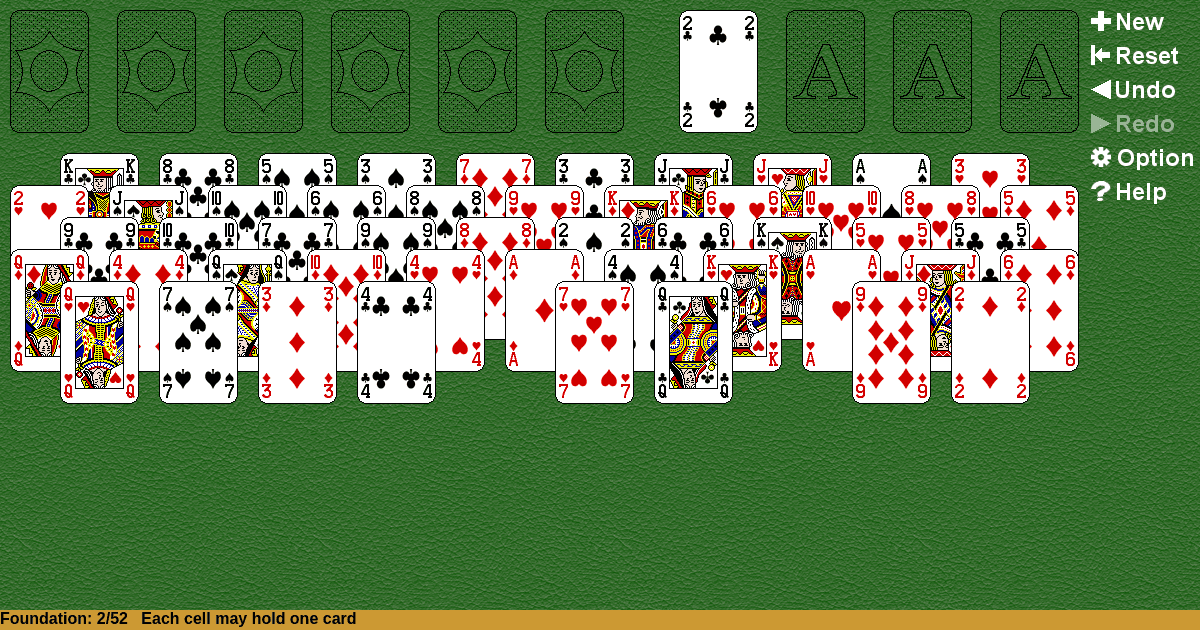Sarlacc
Home |
How to play |
FAQ |
About
How to play Sarlacc?
Game Objective:
The primary goal in Sarlacc Solitaire is to move all cards from the tableau and cells to the foundation piles, building each foundation in ascending order by suit from Ace to King.
Setup & Layout:
- Deck: Use a standard 52-card deck (no Jokers).
- Tableau: The main play area consists of several columns (the exact number may vary by implementation; commonly eight), with cards dealt face-up in each column. All tableau cards are visible at the start.
- Cells: There are six cells, each initially empty. Each cell can hold only one card at a time.
- Foundations: Four foundation piles (one for each suit), all start empty.
- Stock/Waste: Sarlacc Solitaire does not use a stock or waste pile; all cards are dealt to the tableau and cells at the start.
Sarlacc Solitaire Rules:
- Card Movement Principles:
- Any available card (top card of a tableau column or any card in a cell) may be moved to a foundation pile or an empty cell.
- Only one card may occupy a cell at a time.
- Cards from cells may be played back to the tableau or directly to foundations.
- Building Sequences:
- Sequences in the tableau are built down by alternating color (e.g., red 7 on black 8).
- Only the top card of each tableau column or a card in a cell may be moved.
- Foundation Building:
- Foundations are built up by suit, starting from Ace and ending with King (Ace, 2, 3, …, King).
- Moving Cards:
- Only one card may be moved at a time, either to a cell, to another tableau column (if it follows the alternating color sequence), or to a foundation.
Gameplay:
- Typical Sequence of Actions:
- Move any available card (from tableau or cell) to a foundation if possible.
- Move a card to a cell if it helps free up other moves.
- Move a card to another tableau column if it continues a descending, alternating color sequence.
- Introducing New Cards:
- There is no stock or reserve; all cards are available from the initial deal.
- Cells act as temporary storage for maneuvering cards.
- No More Legal Moves:
- If no moves are possible (no cards can be moved to foundations, cells, or to continue tableau sequences), the game ends and is considered lost.
Winning & Losing Conditions:
- Winning:
- The game is won when all cards are moved to the foundation piles, built up in suit from Ace to King.
- Losing/Unwinnable State:
- The game is lost if no further legal moves are possible and not all cards are in the foundations.
Special Rules & Edge Cases:
- Filling Empty Spaces:
- Empty tableau columns can only be filled by a King or a sequence starting with a King, depending on the specific variant rules.
- Empty cells can be filled by any available card from the tableau.
- Unique Restrictions:
- Only one card may occupy each cell at any time.
- Only the top card of each tableau column or a card in a cell may be moved.
- Cards in cells are not locked; they may be moved back to tableau columns or directly to foundations as needed.
If a tableau column becomes empty, the rules for filling it may vary (commonly only Kings or sequences starting with Kings are allowed), but always check the specific implementation for details.
Note: Sarlacc Solitaire is a challenging variant inspired by FreeCell, distinguished by its six cells and strict one-card movement rule. All cards are visible at the start, and success depends on careful planning and optimal use of the cells.

Solitaire Collection
About Sarlacc
Rate (Sarlacc)
4.7 / 5
1,916 votes



























































